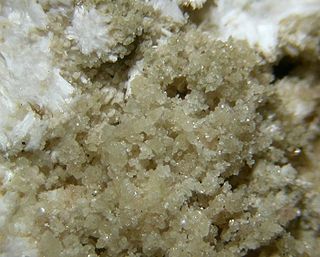
Boehmite or böhmite is an aluminium oxide hydroxide mineral, a component of the aluminium ore bauxite. It is dimorphous with diaspore. It crystallizes in the orthorhombic dipyramidal system and is typically massive in habit. It is white with tints of yellow, green, brown or red due to impurities. It has a vitreous to pearly luster, a Mohs hardness of 3 to 3.5 and a specific gravity of 3.00 to 3.07. It is colorless in thin section, optically biaxial positive with refractive indices of nα = 1.644 – 1.648, nβ = 1.654 – 1.657 and nγ = 1.661 – 1.668.

Hopeite is a hydrated zinc phosphate with formula: Zn3(PO4)2·4H2O. It is a rare mineral used mainly as a collectors specimen.

Lithiophilite is a mineral containing the element lithium. It is lithium manganese(II) phosphate with chemical formula LiMnPO4. It occurs in pegmatites often associated with triphylite, the iron end member in a solid solution series. The mineral with intermediate composition is known as sicklerite and has the chemical formula Li(Mn,Fe)PO4). The name lithiophilite is derived from the Greek philos (φιλός) "friend", as lithiophilite is usually found with lithium.
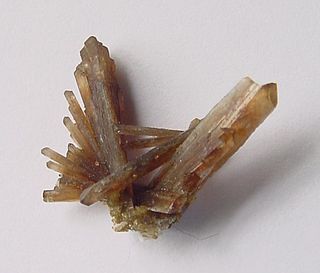
Childrenite is a rare hydrated phosphate mineral with elements iron, manganese, aluminium, phosphorus, oxygen and hydrogen. Its chemical formula is (Fe2+
,Mn)2+
AlPO
4(OH)
2•H
2O and it has a molecular weight of 229.83 g/mol. Its specific gravity is 3.2 and it has a Mohs hardness of 4.5 to 5. It is usually translucent and non-fluorescent, with imperfect cleavage. It has a vitreous lustre with a white streak, and is brown or yellow in color. It has a conchoidal, uneven fracture, and an orthorhombic crystal system.

Triploidite is an uncommon manganese iron phosphate mineral with formula: (Mn, Fe)2PO4OH. It crystallizes in the monoclinic crystal system and typically occurs as elongated and striated slender prisms which may be columnar to fibrous. Its crystals may be pinkish to yellowish brown or red-orange.

Seamanite, named for discoverer Arthur E. Seaman, is a rare manganese boron phosphate mineral with formula Mn3[B(OH)4](PO4)(OH)2. The yellow to pink mineral occurs as small, needle-shaped crystals. It was first discovered in 1917 from a mine in Iron County, Michigan, United States and identified in 1930. As of 2012, seamanite is known from four sites in Michigan and South Australia.

Scorzalite ((Fe2+,Mg)Al2(OH,PO4)2) is a dark blue phosphate mineral containing iron, magnesium, and aluminium phosphate. Scorzalite forms one endmember of a solid solution series with the lighter, more magnesium-rich lazulite.

Eosphorite is a brown (occasionally pink) manganese hydrous phosphate mineral with chemical formula: MnAl(PO4)(OH)2·H2O. It is used as a gemstone.
Xanthoxenite is a rare calcium iron(III) phosphate mineral with formula: Ca4Fe3+2(PO4)4(OH)2·3H2O. It occurs as earthy pale to brownish yellow incrustations and lath shaped crystals. It crystallizes in the triclinic crystal system. It occurs as an alteration product of triphylite in pegmatites. It occurs associated with apatite, whitlockite, childrenite–eosphorite, laueite, strunzite, stewartite, mitridatite, amblygonite and siderite.

Beraunite is an iron phosphate mineral. It was first described by August Breithaupt for an occurrence in Beraun currently in the Czech Republic. Beraunite occurs as a secondary mineral in iron ore deposits, and as an alteration product of primary phosphate minerals in granite pegmatites.

Cyrilovite (NaFe33+(PO4)2(OH)4·2(H2O)) is a hydrous sodium iron phosphate mineral. It is isomorphous and isostructural with wardite, the sodium aluminium counterpart.

Hureaulite is a manganese phosphate with the formula Mn2+5(PO3OH)2(PO4)2·4H2O. It was discovered in 1825 and named in 1826 for the type locality, Les Hureaux, Saint-Sylvestre, Haute-Vienne, Limousin, France. It is sometimes written as huréaulite, but the IMA does not recommend this for English language text.
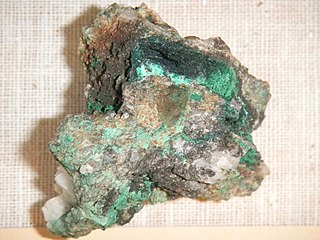
Lipscombite (Fe2+,Mn2+)(Fe3+)2(PO4)2(OH)2 is a green gray, olive green, or black. phosphate-based mineral containing iron, manganese, and iron phosphate.

Allanpringite is a phosphate mineral named after Australian mineralogist Allan Pring of the South Australian Museum. Allanpringite is a Fe3+ analogue Al-phosphate mineral wavellite, but it has a different crystal symmetry – monoclinic instead of orthorhombic in wavellite. It forms needle-like crystals, which are always twinned and form parallel bundles up to about 2 mm long. They are often found in association with other iron phosphates in abandoned iron mines.
Gatehouseite is a manganese hydroxy phosphate mineral with formula Mn5(PO4)2(OH)4. First discovered in 1987, it was identified as a new mineral species in 1992 and named for Bryan M. K. C. Gatehouse (born 1932). As of 2012, it is known from only one mine in South Australia.
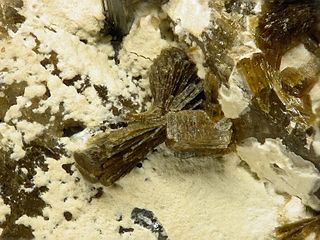
Greifensteinite is beryllium phosphate mineral with formula: Ca2Fe2+5Be4(PO4)6(OH)4·6H2O. It is the Fe2+ dominant member of the roscherite group. It crystallizes in the monoclinic crystal system and typically forms prismatic dark olive green crystals.
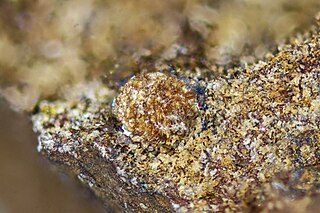
Waterhouseite, Mn7(PO4)2(OH)8, is a hydroxy manganese phosphate mineral. It is a medium-soft, brittle mineral occurring in pseudo-orthorhombic monoclinic bladed crystals and orange-brown to dark brown in color. Waterhouseite is on the softer side with a Mohs hardness of 4, has a specific gravity of 3.5 and a yellowish-brown streak. It is named after Frederick George Waterhouse, first director of the South Australian Museum, as well as recognizes the work Waterhouse Club has done in support of the South Australian Museum.
Falsterite is a rare phosphate mineral with the formula Ca2MgMn2+2(Fe2+0.5Fe3+0.5)4Zn4(PO4)8(OH)4(H2O)14. It is a pegmatitic mineral, related to the currently approved mineral ferraioloite.

Serrabrancaite is a mineral with the chemical formula MnPO4•H2O and which is named for the locality where it was found, the Alto Serra Branca Pegmatite. The Alto Serra Branca mine has been in operation since the 1940s. It is located in Paraiba, Brazil near a village named Pedra Lavrada. Tantalite is the main mineral mined here. Specimens of serrabrancaite are kept in the Mineralogical Collections of both the Bergakademie Freiberg, Germany and the Martin-Luther Universität Halle, Institut für Geologische Wissenschaften.
Rockbridgeite is an anhydrous phosphate mineral in the "Rockbridgeite" supergroup with the chemical formula Fe2+Fe3+4(PO4)3(OH)5. It was discovered at the since-shut-down Midvale Mine in Rockbridge County, Virginia, United States. The researcher who first identified it, Clifford Frondel, named it in 1949 for its region of discovery, Rockbridge County.

















